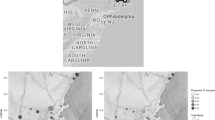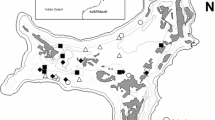Abstract
Non-native species often acquire novel interspecific interactions, which are central to several hypotheses of invasion success, including biotic resistance and invasional meltdown. However, the outcome of these interactions is not often linked with the demographic evidence based on the full life cycle of the species. The Philippine Ground Orchid (Spathoglottis plicata) has invaded Puerto Rico and has acquired both negative and positive interspecific interactions involving the native weevil Stethobaris polita and the invasive red fire ant Solenopsis invicta, respectively. We studied a population in the Rio Abajo Forest, and asked how these interactions affect population demography by using a combination of field, experimental and modelling approaches. Stage-structured matrix population models based on four years of field observations showed that the population of S. plicata is growing at a rate (λ) of 1.05 under natural conditions. When we modified fecundity values based on experimental exclusion of weevils and ants, the control treatment showed a similar λ. Excluding weevils increased λ to 1.20, whereas the exclusion of ants decreased λ to 1.03. When we incorporate demographic and environmental stochasticity in our models, exclusion of invasive red fire ants significantly reduces the orchid abundance over time. Although weevils offer some biotic resistance to S. plicata, these effects do not prevent orchid population growth and expansion. On the other hand, invasive red fire ants have a positive effect on the invasive orchid’s λ, partially supporting the invasional meltdown hypothesis. This study presents a method that allows one to combine opposing mechanisms of species interactions within the same quantitative framework, and the results highlight the importance of considering acquired plant–animal interactions and stochastic processes when evaluating the population growth rates and dynamics of invasive plants.

Weevil image by Tom Murray, and ant image by WP Amstrong (modified and used with authorization)



Weevil image by Tom Murray (modified and used with authorization)
Similar content being viewed by others
Change history
25 November 2016
An Erratum to this paper has been published: https://doi.org/10.1007/s10530-016-1337-5
References
Ackerman JD (1995) An orchid flora of Puerto Rico and the Virgin Islands. Mem N Y Bot Gard 73:1–201
Ackerman JD (2007) Invasive orchids: weeds we hate to love. Lankesteriana 7:19–21. doi:10.15517/lank.v7i1-2.18386
Ackerman JD, Sabat A, Zimmerman JK (1996) Seedling establishment in an epiphytic orchid: an experimental study of seed limitation. Oecologia 106:192–198. doi:10.1007/BF00328598
Ackerman JD, Falcón W, Recart W (2011) New records of naturalized orchids for the Hawaiian Islands. Bish Mus Occas Pap 110:1–4
Ackerman JD, Falcón W, Molinari J et al (2014) Biotic resistance and invasional meltdown: consequences of acquired interspecific interactions for an invasive orchid, Spathoglottis plicata in Puerto Rico. Biol Invasions 16:2435–2447. doi:10.1007/s10530-014-0676-3
Allendorf FW, Lundquist LL (2003) Introduction: population biology, evolution, and control of invasive species. Conserv Biol 17:24–30. doi:10.1046/j.1523-1739.2003.02365.x
Axelrod FS (2011) A systematic vademecum to the vascular plants of Puerto Rico. BRIT Press, Fort Worth
Batty AL, Dixon KW, Sivasithamparam K (2000) Soil seed-bank dynamics of terrestrial orchids. Lindleyana 15:227–236
Bayman P, Gonzalez EJ, Fumero JJ, Tremblay RL (2002) Are fungi necessary? How fungicides affect growth and survival of the orchid Lepanthes rupestris in the field. J Ecol 90:1002–1008
Bronstein JL (1998) The contribution of ant-plant protection studies to our understanding of mutualism. Biotropica 30:150–161. doi:10.1111/j.1744-7429.1998.tb00050.x
Caswell H (2001) Matrix population models. Sinauer Associates Incorporated, Sunderland
Chamberlain SA, Holland JN (2009) Quantitative synthesis of context dependency in ant–plant protection mutualisms. Ecology 90:2384–2392. doi:10.1890/08-1490.1
D’Antonio C, Meyerson LA (2002) Exotic plant species as problems and solutions in ecological restoration: a synthesis. Restor Ecol 10:703–713. doi:10.1046/j.1526-100X.2002.01051.x
D’Antonio CD, Levine J, Thomsen M (2001) Ecosystem resistance to invasion and the role of propagule supply: a California perspective. J Mediterr Ecol 2:233–245
Davis LR, Vander Meer RK, Porter SD (2001) Red imported fire ants expand their range across the West Indies. Fla Entomol 84:735–736. doi:10.2307/3496416
Diez JM (2007) Hierarchical patterns of symbiotic orchid germination linked to adult proximity and environmental gradients. J Ecol 95:159–170. doi:10.1111/j.1365-2745.2006.01194.x
Elton CC (1977) The invaders. The ecology of invasions by animals and plants. Springer, Dordrecht, pp 15–32
Ewel JJ, Whitmore JL (1973) The ecological life zones of Puerto Rico and the U.S. Virgin Islands. Forest Service Research Paper ITF-18. Institute of Tropical Forestry, Río Piedras, Puerto Rico
Fieberg J (2004) Population viability analysis. J Biogeogr 31:515–516. doi:10.1046/j.0305-0270.2003.01027.x
Fisher BL, Zimmerman JK (1988) Ant/orchid associations in the Barro Colorado national monument, Panama. Lindleyana 3:12–16
Hastings A (1997) Population biology: models and concepts. Springer, New York
Hochberg Y (1988) A sharper Bonferroni procedure for multiple tests of significance. Biometrika 75:800–802. doi:10.1093/biomet/75.4.800
Holle BV, Simberloff D (2005) Ecological resistance to biological invasion overwhelmed by propagule pressure. Ecology 86:3212–3218. doi:10.1890/05-0427
Horvitz CC, Schemske DW (1995) Spatiotemporal variation in demographic transitions of a tropical understory herb: projection matrix analysis. Ecol Monogr 65:155. doi:10.2307/2937136
Jersáková J, Malinova T (2007) Spatial aspects of seed dispersal and seedling recruitment in orchids. New Phytol 176:237–241. doi:10.1111/j.1469-8137.2007.02223.x
Jolliffe K (2010) Epiphytic orchids of the Seychelles. Kapisen 10:6–8
Katsukawa Y, Katsukawa T, Matsuda H (2002) Indeterminate growth is selected by a trade-off between high fecundity and risk avoidance in stochastic environments. Popul Ecol 44:265–272. doi:10.1007/s101440200030
Kearns CA, Inouye DW (1993) Techniques for pollination biologists. University Press of Colorado, Boulder
Kelly C, Dyer R (2002) Demographic consequences of inflorescence-feeding insects for Liatris cylindracea, an iteroparous perennial. Oecologia 132:350–360. doi:10.1007/s00442-002-0948-y
King JR, Tschinkel WR (2008) Experimental evidence that human impacts drive fire ant invasions and ecological change. Proc Natl Acad Sci USA 105:20339–20343. doi:10.1073/pnas.0809423105
Kores P (1980) Pollination mechanisms as a limiting factor in the development of the Orchidaceous Flora of Hawai’i. Department of Botany, University of Hawai’i at Manoa
Lach L, Tillberg CV, Suarez AV (2010) Contrasting effects of an invasive ant on a native and an invasive plant. Biol Invasions 12:3123–3133. doi:10.1007/s10530-010-9703-1
Lefkovitch LP (1965) The study of population growth in organisms grouped by stages. Biometrics 21:1–18. doi:10.2307/2528348
Leonhardt K, Sewake K (eds) (1999) Growing Dendrobium orchids in Hawaii. College of Tropical Agriculture and Human Resources, University of Hawaii, Honolulu
Levine JM, D’Antonio CM (1999) Elton revisited: a review of evidence linking diversity and invasibility. Oikos 87:15. doi:10.2307/3546992
Levine JM, Adler PB, Yelenik SG (2004) A meta-analysis of biotic resistance to exotic plant invasions. Ecol Lett 7:975–989. doi:10.1111/j.1461-0248.2004.00657.x
Mailleux A-C, Deneubourg J-L, Detrain C (2000) How do ants assess food volume? Anim Behav 59:1061–1069. doi:10.1006/anbe.2000.1396
McCullough DR, Work TT, Cavey JF et al (2006) Interception of nonindigenous plant pests at US ports of entry and border crossing over a 17-year period. Biol Invasions 8:611–630. doi:10.1007/s10530-005-1798-4
Mitchell CE, Agrawal AA, Bever JD et al (2006) Biotic interactions and plant invasions. Ecol Lett 9:726–740. doi:10.1111/j.1461-0248.2006.00908.x
Moloney KA (1986) A generalized algorithm for determining category size. Oecologia 69:176–180. doi:10.1007/BF00377618
Montalvo AM, Ackerman JD (1987) Limitations to fruit production in Ionopsis utricularioides (Orchidaceae). Biotropica 19:24–31
Morris WF, Doak DF (2002) Quantitative conservation biology. Sinauer Associates Inc, Sunderland
Murren CJ, Ellison AM (1998) Seed dispersal characteristics of Brassavola nodosa (Orchidaceae). Am J Bot 85:675–680
Ness JH, Bronstein JL (2004) The effects of invasive ants on prospective ant mutualists. Biol Invasions 6:445–461
Parker JD, Hay ME (2005) Biotic resistance to plant invasions? Native herbivores prefer non-native plants. Ecol Lett 8:959–967. doi:10.1111/j.1461-0248.2005.00799.x
Pfeifer M, Wiegand K, Heinrich W, Jetschke G (2006) Long-term demographic fluctuations in an orchid species driven by weather: implications for conservation planning. J Appl Ecol 43:313–324. doi:10.1111/j.1365-2664.2006.01148.x
Porter SD, Savignano DA (1990) Invasion of polygyne fire ants decimates native ants and disrupts arthropod community. Ecology 71:2095. doi:10.2307/1938623
Porter SD, Van Eimeren B, Gilbert LE (1988) Invasion of red imported fire ants (Hymenoptera: Formicidae): microgeography of competitive replacement. Ann Entomol Soc Am 81:913–918
Prakash N, Leelee A (1973) Life-history of a common Malaysian orchid Spathoglottis plicata. Phytomorphology 23:9–17
R Core Team (2015) R: a language and environment for statistical computing
Ramula S, Knight TM, Burns JH, Buckley YM (2008) General guidelines for invasive plant management based on comparative demography of invasive and native plant populations. J Appl Ecol 45:1124–1133
Recart W, Ackerman JD, Cuevas AA (2013) There goes the neighborhood: apparent competition between invasive and native orchids mediated by a specialist florivorous weevil. Biol Invasions 15:283–293. doi:10.1007/s10530-012-0283-0
Richardson DM, Pysek P (2006) Plant invasions: merging the concepts of species invasiveness and community invasibility. Prog Phys Geogr 30:409–431. doi:10.1191/0309133306pp490pr
Richardson DM, Allsopp N, D’Antonio CM et al (2007) Plant invasions—the role of mutualisms. Biol Rev 75:65–93. doi:10.1111/j.1469-185X.1999.tb00041.x
Rico-Gray V, Thien LB (1989) Effect of different ant species on reproductive fitness of Schomburgkia tibicinis (Orchidaceae). Oecologia 81:487–489
Rosenberg K, Boland J, Tiver F, Watson I (2005) Application of the Vandermeer-Moloney Algorithm for determination of category size to Australian native plants. MODSIM 05 International Conference on Modelling and Simulation, December 2005. University of Melbourne, Modelling and Simulation Society of Australia and New Zealand
Sakai AK, Allendorf FW, Holt JS et al (2001) The population biology of invasive species. Annu Rev Ecol Syst 32:305–332. doi:10.1146/annurev.ecolsys.32.081501.114037
Schilman PE (2011) Trail-laying behaviour as a function of resource quality in the ant Camponotus rufipes. Psyche 2011:1–5. doi:10.1155/2011/139385
Schödelbauerová I, Tremblay RL, Kindlmann P (2009) Prediction vs. reality: can a PVA model predict population persistence 13 years later? Biodivers Conserv 19:637–650. doi:10.1007/s10531-009-9724-1
Simberloff D, Von Holle B (1999) Positive interactions of nonindigenous species: invasional meltdown? Biol Invasions 1:21–32. doi:10.1023/A:1010086329619
Smith MR (1936) The ants of Puerto Rico. J Agric Univ P R 20:819–875
Strauss SY, Irwin RE (2004) Ecological and evolutionary consequences of multispecies plant-animal interactions. Annu Rev Ecol Evol Syst 35:435–466. doi:10.1146/annurev.ecolsys.35.112202.130215
Stubben C, Milligan B (2007) Estimating and analyzing demographic models using the popbio package in R. J Stat Softw 22:1–23. doi:10.18637/jss.v022.i11
Thompson SA, Wright FW (1995) Spathoglottis plicata (Orchidaceae): new to Dominica, another record from the Lesser Antilles. Caribb J Sci 31:2
Torres JA (1984) Niches and coexistence of ant communities in Puerto Rico: repeated patterns. Biotropica 16:284–295
Tremblay RL, Hutchings MJ (2003) Population dynamics in orchid conservation: a review of analytical methods based on the rare species Lepanthes eltoroensis. In: Dixon KW, Kell SP, Barret RL, Cribb PJ (eds) Orchid conservation. Natural History Publications, Kota Kinabalu
Van Der Cingel NA (2001) An atlas of orchid pollination: European orchids. CRC Press, Boca Raton
Vandermeer J (1978) Choosing category size in a stage projection matrix. Oecologia 32:79–84. doi:10.1007/BF00344691
Wetterer JK, Snelling RR (2006) The red imported fire ant, Solenopsis invicta, in the Virgin Islands (Hymenoptera: Formicidae). Fla Entomol 89:431–434
Zotz G, Schmidt G (2006) Population decline in the epiphytic orchid Aspasia principissa. Biol Conserv 129:82–90. doi:10.1016/j.biocon.2005.07.022
Acknowledgements
The PR-LSAMP Bridge to the Doctorate Fellowship (HRD-0601843), and the Center for Applied Tropical Ecology and Conservation (HRD-0734826) provided economical and logistical support to this project, for which we are grateful. We also want to thank Rafael D. Rodríguez, Joham Ríos, Taisa Alicea, Gilberto Colón, Rebecca Hernández, Wilnelia Recart and Jonathan Molinary for their help the during the many hours of fieldwork. Drs. Riccardo Papa and Ingi Agnarsson provided insightful comments and suggestion to do this project, for which we are grateful. We also thank Caner Aktas for his much appreciated help with part of the R code. Finally, we are very grateful to the anonymous reviewers, and the editors, whose comments and suggestions greatly improved this article.
Author information
Authors and Affiliations
Corresponding author
Electronic supplementary material
Below is the link to the electronic supplementary material.
Rights and permissions
About this article
Cite this article
Falcón, W., Ackerman, J.D. & Tremblay, R.L. Quantifying how acquired interactions with native and invasive insects influence population growth rates of a non-indigenous plant. Biol Invasions 19, 895–911 (2017). https://doi.org/10.1007/s10530-016-1318-8
Received:
Accepted:
Published:
Issue Date:
DOI: https://doi.org/10.1007/s10530-016-1318-8




